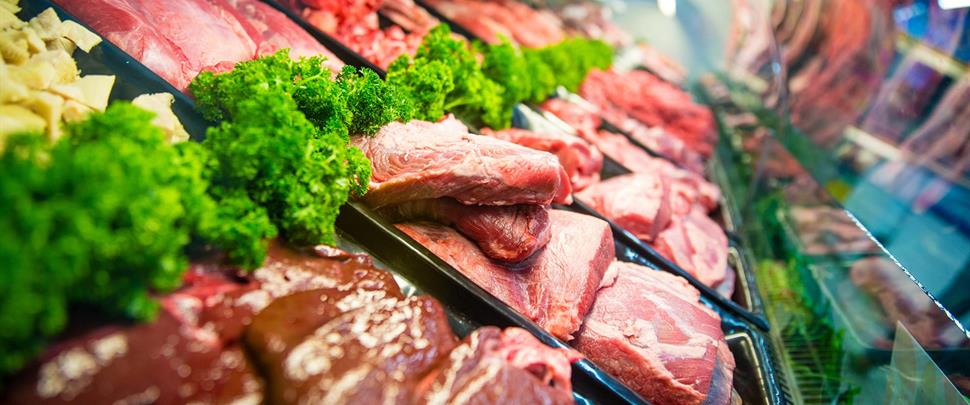Does Red Meat Cause Diabetes?
Date: Thursday, March 04, 2021
Several studies have suggested that eating too much red and processed meats can increase your risk of Type 2 diabetes.

Our body needs protein to build and repair bones, muscles, skin and blood. We also use protein to make enzymes, hormones and other body chemicals essential for proper body functioning.
Red meat, poultry, seafood, eggs, dairy, beans and peas, soy products, nuts and seeds are considered part of the protein food group.
Does Red Meat Cause Diabetes?
Several studies[1],[2],[4] have suggested that eating too much red and processed meats can increase your risk of Type 2 diabetes. Red meat includes pork, beef, mutton and veal. Processed meats are meats that are preserved by curing, salting, smoking, drying or canning. Hot dogs, bacon, ham, sausages, corned beef and canned luncheon meat are examples of processed meats.
In one study,[3] researchers observed a group of middle-aged men and women for four years. They found that those who increased their red meat intake by half a serving a day had a 48 percent higher risk of developing Type 2 diabetes than if they had not changed their diet. Those who reduced their red meat intake, on the other hand, had a lower risk.
Processed red meat is especially bad for your health[4]. It is believed that the preservatives, additives and chemicals (e.g. nitrites, nitrates) that are added to the meat during manufacturing can harm your pancreas (organ that produces insulin) and increase insulin resistance.
As red meat is a source of saturated fat, cholesterol, animal protein and haem-iron (iron containing substance), scientists suspect these substances in red meat may also contribute to the increased diabetes risk. How and why this is so is still unclear. Some think that iron overload in the body can promote insulin resistance and raise blood glucose levels.
What Can I Do to Prevent Diabetes?
Eat a Variety of Healthy Protein-rich Foods.
Add variety and nutrition to your meal plan by varying the type of protein you eat. Using My Healthy Plate, fill a quarter of your plate with quality protein-rich foods such as:
Soy products like tofu and tempeh are high in protein and low in calories and carbohydrates.
Eggs as a source of high-quality protein are a great choice for breakfast, lunch or dinner. You can have them scrambled, poached, sunny-side up, half-boiled or hard-boiled.
Seafood, which includes fish and shellfish, have lower saturated fat and cholesterol than most red meat and poultry. Fatty fish (salmon, tilapia and sea bass) are also a great source of omega-3 fatty acids.
Dairy products have some protein and are a source of healthy carbohydrates. Go for low-fat or non-fat milk and yoghurt.
Nuts and seeds make great snacks. As nuts and nut butters contain fat and are dense in calories, watch how much you eat. Go with a handful of nuts or two tablespoons of nut butter as a portion size.
Poultry (chicken, turkey) is high in protein with less saturated fat and cholesterol than red meat. Choose breast meat which has less fat than the leg and thigh.
There’s No Need to Cut Red Meat out of your Diet
Red meat is rich in vitamins and essential minerals. Just because red meat consumption is linked to higher diabetes risk does not mean you have to give it up.
Here are healthier ways to include red meat in your diet:
Go easy on processed meat. Fresh meat is best.
Think of red meat as a treat. That means having it on special occasions, cutting down on the amount per serving and using it to add flavour than as the main dish.
Choose leaner cuts. The terms “loin” (sirloin, tenderloin) and “round” indicate lean cuts. And the less marbling you see in the meat, the leaner it will be. When preparing the meat, trim off as much fat as possible.
Broil or grill to remove even more fat.
When grilling, avoid charring your meat.
Other healthy ways of preparing red meat include sautéing, baking, roasting and broiling.
Use My Healthy Plate as a guide to control your portion sizes.
Go Meatless Once in a While
Try a meatless meal or two during the week using plant-based proteins like beans, peas, lentils, tofu and tempeh. Plant-based proteins and fats can provide health benefits. Going meatless occasionally can be kind to your wallet and good for the planet. It takes a lot more energy to grow animal meat for protein than plants.
To lower your risk of diabetes, go easy on red meat. Adopt healthy eating habits to give your body the nutrients it needs. Check out these healthy recipes to whip up your next meal.
References
Jiang, R., Ma, J., Ascherio, A., Stampfer, M. J., Willett, W. C., Hu, F. B. (2004). Dietary iron intake and blood donations in relation to risk of type 2 diabetes in men: a prospective cohort study. American Journal of Clinical Nutrition, 79, 70-75.
Retrieved from http://ajcn.nutrition.org/content/79/1/70.longPan, A., Sun, Q., Bernstein, A. M., Schulze, M. B., Manson, J. E., Hu, F. B. (2011). Red meat consumption and risk of type 2 diabetes: Three cohorts of US adults and an updated meta-analysis. Americanl< Journal of Clinical Nutrition, 94, 1088-1096.
Retrieved from https://www.ncbi.nlm.nih.gov/pubmed/21831992Pan A, Sun Q., Bernstein, A. M., Schulze, M. B., Manson, J. E., Hu, F. B. (2013). Changes in red meat consumption and subsequent risk of type 2 diabetes melltius: Three cohorts of US men and women. JAMA Intern Med, 173(14), 1328-1335.
Retrieved from http://jamanetwork.com/journals/jamainternalmedicine/fullarticle/1697785Song, Y. Q., Manson, J. E., Buring, J. E. & Liu, S. (2004). A prospective study of red meat consumption and type 2 diabetes in middle-aged and elderly women. Diabetes Care. 27(9), 2108-2115.
Retrieved from http://care.diabetesjournals.org/content/27/9/2108
Contributed By: Health Promotion Board (HPB)
Does Red Meat Cause Diabetes? by Health Promotion Board, 22 Feb 2021, www.healthhub.sg.